Your cart is currently empty!
Pinch Pot Artists – 12 Potters Using the Pinching Technique
Published:
Last Updated:
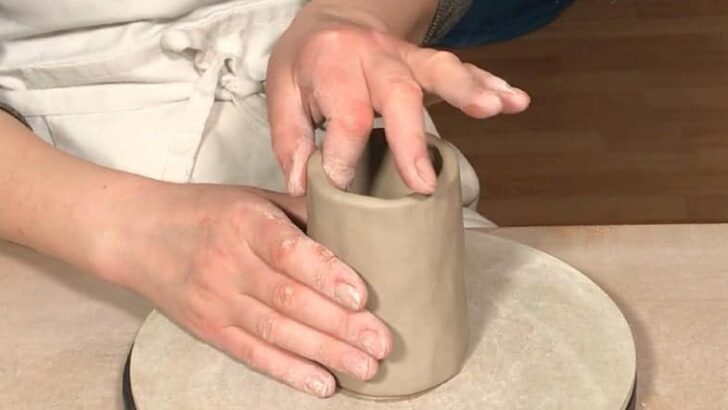
Affiliate Disclaimer
As an affiliate, we may earn a commission from qualifying purchases. We get commissions for purchases made through links on this website from Amazon and other third parties.
The pinching technique can be used to make exquisite pottery and artwork. Here are 12 pinch pot artists, who demonstrate how refined and creative the pinching technique can be. The breadth and diversity of their work illustrates how versatile pinching clay as a method of hand building can be.
The following pinch pot artists are presented in alphabetical order.
- Ingrid Bathe
- Lynda Draper
- David Eichelberger
- Vicki Grima
- Lindsay Klix
- Leanne McClurg Cambric
- Jenny Mendes
- Elspeth Owen
- Mary E Rogers
- Emily Schroeder Willis
- Holly Walker
- Lilly Zuckerman
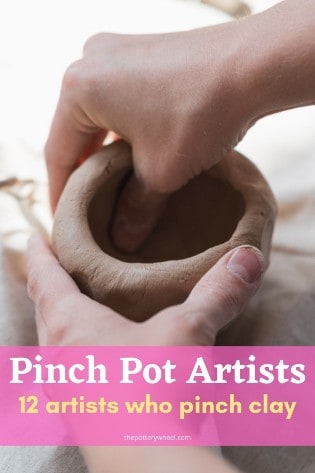
12 Pinch Pot Artists
The first maker in this overview of pinch pot artists is the ceramic artist Ingrid Bathe…
Ingrid Bathe
Ingrid Bathe attained her BFA at the Museum School of Fine Art, In Boston. And went on to take an MFA in Ceramics at Ohio University. She currently lives and works in Maine.
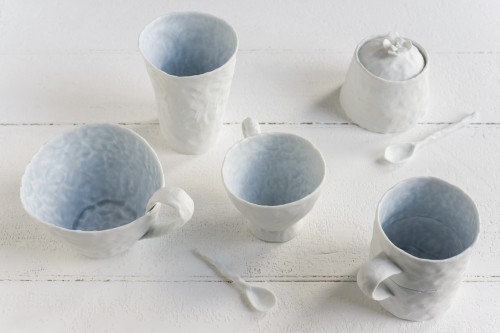
Ingrid works in porcelain. She mixes paper fiber into the porcelain clay. This makes the clay stronger when it is greenware, but it burns out of the clay whilst it is fired. So, it doesn’t affect the quality or strength of the finished pot.
Ingrid uses the pinching method to produce thin-walled functional vessels such as cups, bowls, platters, vases, and cake stands. In spite of being thin-walled and looking refined and delicate, her pieces are durable.
This is because they are fired to 2150F. At these temperatures, the clay starts to vitrify, which means it becomes glass-like. The formation of glass in the clay makes it translucent but also dense and strong.
Ingrid leaves evidence of her craftsmanship on her pieces. Finger marks and fingerprints are left where a pinch has been made. And seams, at the point where clay has been joined, are left for the user to see and feel. She states, that she ‘wants the process of creation to be visible to the viewer’. (source)
The outside of her pottery has a soft unglazed sheen. And the inside of her pots are decorated with a glaze that looks blue or lavender depending on the light.
Lynda Draper
Lynda Draper was born in Sydney, Australia. She studied Ceramics at the National Art School, Sydney. And she completed a Master of Fine Arts at UNSW College of Fine Arts. She is currently Head of Ceramics at the National School of Art in Sydney.
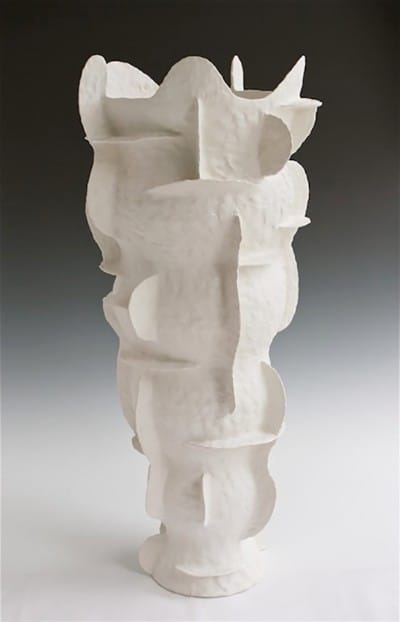
Lynda describes herself as a visual artist, who works mainly in the ceramic medium. She has worked in ceramics for around 35 years, and her catalog of work extends from 1987 to date. However, in Artist Profile, she states that her work from the 1980s is most ‘in keeping’ with her recent work.
Between 1987 and 2005, her use of the pinching technique was visible on the surface of her pieces. Between 1987 and 1990, she worked using porcelain clay. She pinched the clay to ‘push the material to new technical and aesthetic limits’.
These pieces were pinched and then decorated with colorful engobes, underglazes, and glazes. Lynda talks about how these vessels look like they are made from papier-mache and wax.
However, in the late 80’s she started to use less color in her work. She connects this change to moving into an old farmhouse, that contained centuries of old artifacts, utensils, and furniture.
The history behind the contents of the house inspired a series of work. She talks about wanting to make “dreamlike ceramic sculptures” that look fragile but that have the strength of fired clay.
David Eichelberger
David Eichelberger has a BFA from Virginia Tech, Blacksburg, and a Master’s degree from the University of Nebraska-Lincoln. He has been a resident artist at a number of institutions. Most recently he was a Professor of Art at Marlboro College, in Marlboro, Vermont, where he lives with his family. He operates TWO-ONE Ceramics with his wife, artist Elisa DiFeo.
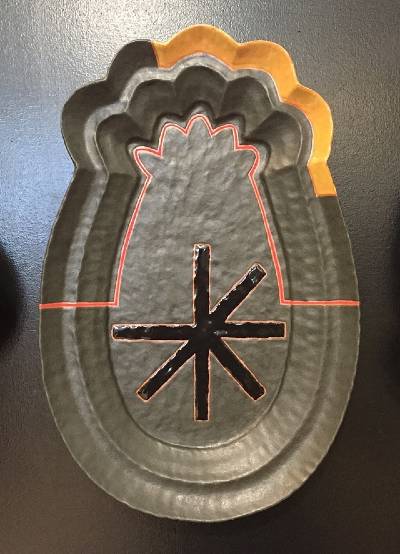
David hand-builds his work and uses the pinching technique. He sometimes works with red terracotta clay. At other times he uses porcelain paper clay.
One of the techniques he uses is to make a hand-built bisque ring that acts a little like a mold. He uses the ring to support clay as he pinches his vessels. The rings are a guide to help him transform the ideas in his sketchbook into a clay form. (source)
Some of his older work uses matte and glossy black glaze on terra-cotta. This is ‘reminiscent of Native American black on black wares’. (source)
His more recent work is also built with red earthenware clay. However, it is painted with a thin layer of white clay. David sometimes draws images onto his work. He describes these drawings as “simple stories in images”. His intention is that they “remind us of quiet, routine endeavors, and grant them a value”.
With his current work, he uses the sgraffito technique and scratches drawings onto the white slip. This reveals the red clay underneath. The vessels are then bisque fired, glazed, and fired a second time at earthenware temperatures.
David points out that his simple surfaces highlight the pinch marks in the clay. And that these finger marks are an indication of the time and care that has gone into the piece. (source) This feeling is shared by other pinch pot artists.
If you’d like to learn how to make pinch pots, you can download this free ebook on making a pinch pot teapot.
Vicki Grima
Vicki Grima is a ceramic artist who lives in Sydney, Australia. She has taught visual arts to secondary students and adults. And she is the Editor of the Journal of Australian Ceramics. In addition to this, she is the Executive Officer of the Australian Ceramics Association.
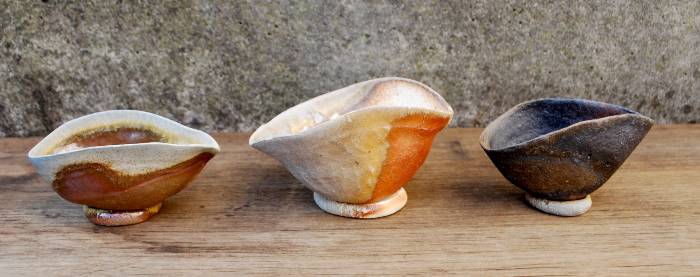
These responsible roles keep Vicki busy. And she acknowledges that her artwork gets fitted into the limited time that is left. (source) She describes how she uses the time she does have to center and focus herself. Her studio is a place of retreat and creative solace.
When describing the way she works, Vicki states that what she loves to do most is make small pinch pots. She will often pinch the clay with her eyes closed. She relies on her sense of touch to gauge the thickness of the clay.
When she is pinching the clay she moves her hands in a spiral movement. With her eyes closed, Vicki states that this feels like a meditative practice.
If she is working with porcelain, she presses organic materials into the outside surface of the bowl. Shells sticks and coral will leave imprints in the clay. And the indented sections are thin enough to be translucent. More recently she has become passionate about wood firing.
The random tones and shades of wood firing complement her organic-looking work. And reflects the inspiration that she takes from the natural world.
Lindsay Klix
Lindsay Klix is the owner of Off Your Rocker Pottery and lives in Illinois. She began making pottery in 1998. Her journey began after being persuaded by a tutor at a local community college to take a ceramics class.
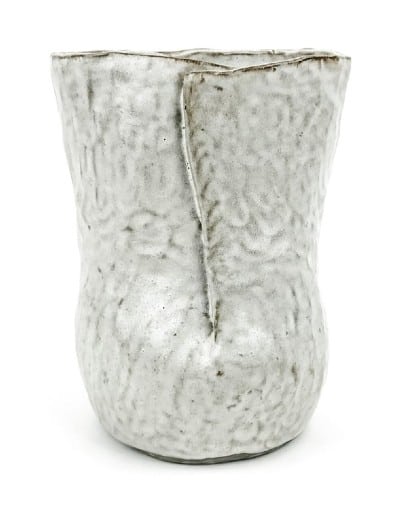
For some years, she made pottery as a pastime and simply for her own enjoyment. But after having a family she decided to focus her creative energy on starting an online pottery business and store.
Lindsay uses a variety of techniques for her pottery, all of which is hand-made. She has a range of beautifully made pots that are made using the pinching technique. Many of her pieces are part of a dinner set, but she also makes vases and vessels.
Her ethos is to produce quality items that are a joy to use. She emphasizes that her pottery is to be used on a daily basis and also for those special occasions. Part of the motivation for this is the satisfaction of using a beautifully made item. But, she also expresses an environmental concern of wanting to value the items we have and reduce waste.
Part of her inspiration is to bring the process back to basics, where pottery making began. She describes the work of pinch pot artists as an ancient process, but one that has lasted the test of time. Its beauty, she feels, is in the simplicity of just the clay and the artist’s hands, one touch or pinch at a time.
Some of the pinch pots that she made in her dinnerware range have flush curved sides. Other pieces have pinched seams that give the pot a distinctive look.
Lindsay is a keen cook and she has used this passion to inform the dinnerware pottery that she makes. It’s important that her pottery is functional, beautiful, and enjoyable to use.
Leanne McClurg Cambric
Leanne McClurg grew up in Alaska and lives in south Chicagoland. She attained her BFA from the University of Minnesota and her MFA from Louisiana State University.
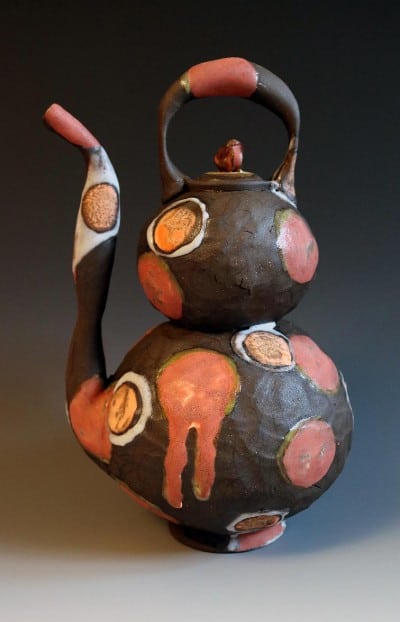
Most of her work is hand built using porcelain clay. She employs a combination of hand building techniques and uses pinching to shape the clay. Leanne has said that the fingerprints left by the pinching process highlight the handmade origins of the vessel.
She also describes her functional vessels as a vehicle to connect with the user. She feels that her art is ‘an extension of my physical being’. (source) As such, the pinch marks made by her fingers are evidence of her body. And, she describes her fingerprints in the clay as ‘a record of my existence that I want to communicate’.
Over the years, the designs on her pottery have become more graphic. Leanne draws on her pots first and then layers glazes onto the piece. She describes her approach to glazing as ‘painterly’. The glazes melt over the drawings, and the overall effect is a combination of “hard and soft lines”.
She discusses the representation of animals in her work in a talk at the Baton Rouge Gallery in 2011. Animals are used to illustrate themes of survival and self-preservation. They are used as a metaphor for human experience.
Some other fundamental themes that run throughout Leanne’s work are connection with others, loss, and longing. And poetically, she points out that like a ceramic pot people are both fragile and strong.
Jenny Mendes
Jenny Mendes is a ceramic artist who lives and works in Ohio, US. She studied ceramics at Washington University in St Louis. And completed a fellowship at Penland School of Crafts in North Carolina.
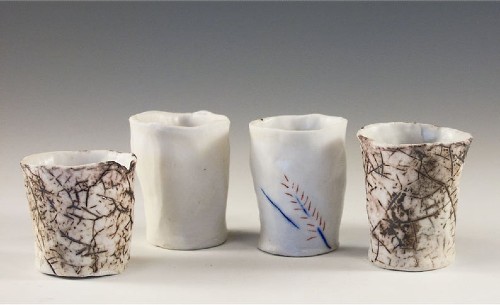
Jenny currently produces ceramic art, watercolor paintings, and prints. Her ceramic pieces are often beautifully decorated with painted designs. So, it’s not surprising to me that she has a passion for painting and ceramics.
In an interview with the American Craft Council, Jenny talks about the importance of painting in her ceramic work. She explains that when she was learning her craft she focused as much on shaping the clay as decorating it. However, with time, her ceramic work has become a canvas for her painting. She describes how the images and designs she paints are an expression of her unconscious imagination.
Her ceramic work is hand built and she uses a combination of different techniques, including pinching and coiling.
This pinched pottery bowl is a lovely example of how she combines her love of clay and painting. The bowl is made using the pinching technique. She has used terracotta clay and painted the outside of the bowl with terra sigillata. This gives it a beautiful burnished look. The inside of the bowl is painted with underglazes and then clear glazed.
Elspeth Owen
Elsbeth Owen was born in 1938 and currently lives just outside Cambridge UK. Between 1957 and 1960, she studied modern history at Oxford University. After this time, she became a self-taught potter and one of the most highly respected pinch pot artists.
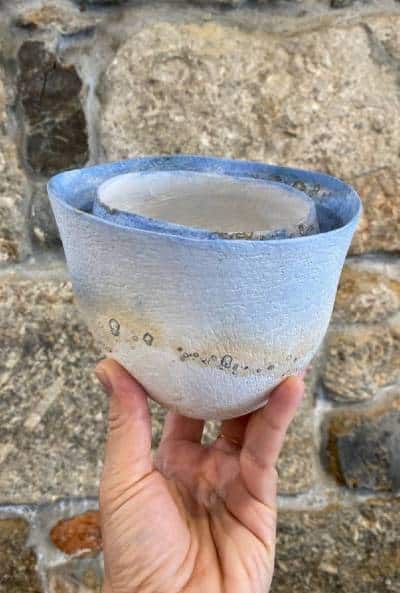
Elsbeth pinches her pots and decorates them with clay slip. The clay slips contain different colorants in the form of oxides and stains. Once the slip has been applied she rubs some of it away to reveal the texture of the pot underneath. This creates a mixture of colors and textures, with some areas of the pot being bare clay.
She also burnishes her pottery with a small stone that she has used for many years. In a film made by Art Talks with Art Fund, she talks of feelings of pride for her burnishing stone. She has used the stone for so many years it has been flattened on one side.
Being able to interact with her pottery using the senses is important to Elsbeth. She prefers for people to be able to touch her pottery rather than looking at it in a glass case. Elsbeth believes that by touching her pots, you get a feel for their weight, texture, and character. She feels that it’s only through touch that you can know a piece of pottery. And, she refers to this as ‘unavoidable knowing’. (source).
Elsbeth talks about making the pots and giving them to a person as part of the same creative process. In one project, one person would buy one of her pots for another person. Then Elspeth would deliver the pot to the recipient herself. She enjoyed the experience of being on the road. The process of making the pot, giving it to the recipient, and returning home feels like a complete cycle.
Mary E Rogers
Mary E Rogers was born in 1929 in Belper, Derbyshire, UK. She studied at the Watford School of Art and St Martin’s School of Art in London.
She took up ceramics at the Loughborough School of Art. From 1960 – 1964 she studied with David Leach. Initially, she worked hand built her pottery using stoneware and porcelain. However, around 1968 she began to work mainly with porcelain because of its translucency.
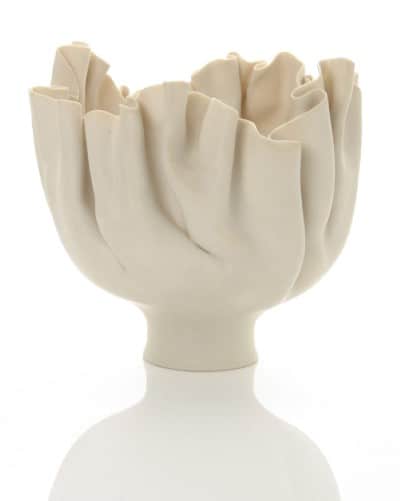
Mary is the author of a book entitled Mary Rogers on Pottery and Porcelain – A Handbuilder’s Approach (1979). In this, she describes some of her techniques and methods as a pinch pot artist.
Her Pinching Process
One of the methods she describes is a combination of pinching and coiling. This is a technique used by many pinch pot artists. Especially when building larger pots.
She describes starting off with a “fairly rough and thick-walled pinch pot”. She then rested the pinched base on a piece of soft sponge.
About three coils of clay are added to the rim of the pinch pot. These coils were blended together on the inside and outside of the pot. And once they were securely attached, she would pinch out the shape and form of the pot.
The pot is then left inverted at times to allow the clay to firm up. This would make it easier to continue building up the walls of the pot and pinching out the shape.
Mary describes making the coils of clay that she adds, by pinching them roughly from a lump of clay. If she was working on a large piece, the clay coil would rest on her wrist and forearm.
The pot would then be turned as she added the coil to the pinch pot. As the coil was being added she would smear the clay into the rim of the pot using her thumb.
Once the coils were added she pinched the clay to the thickness that she wanted the final piece to be. However, the rim of the pot would be left a little thicker so she could continue to add further coils.
Mary used this method to produce pinch pots that were very thin-walled and delicate. Her work is said to resemble natural organic objects like leaves, pebbles, and shells.
Emily Schroeder Willis
Emily Schroeder Willis has a BFA in ceramics from the University of Minnesota. And she has an MFA from the University of Colorado, Boulder. Following her MFA, she did a summer residency at the Australian National University of Canberra. And she did a two-year residency at the Archie Bray Foundation for the ceramic arts in Helena, Montana. She currently has a studio in Chicago.
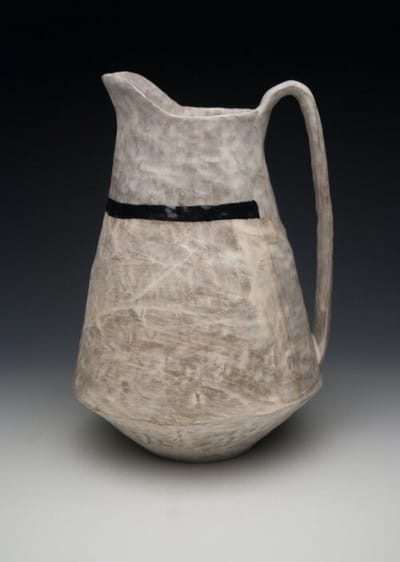
She uses Archie Bray Cone 6 porcelain. Her primary hand building technique is pinching. She uses a combination of her fingers, her lap, and wood tools to create her work. Which is fired at cone 6 in an electric kiln.
Emily talks about wanting to ‘simplify her work’, asking herself if a mark or shape is necessary to the piece. Her method of making is pinching and she tries to ensure that every pinch adds something to the piece. She talks about the pinching process being ‘slow and intimate’. And she reflects that this sets up a particular kind of relationship between the object and the viewer. (source)
Some pinch pot artists will scrape the surface of their pottery to remove the visible finger marks. However, Emily talks about her finger marks being an “impression of the hand that created it”.
When she is making larger pieces, such as a pitcher, Emily uses a combination of pinching and coiling. She will add thick coils to the piece to add height. The coil is firmly attached to the rim of the pot. Then the clay is pinched into the shape that she wants.
Emily talks about the importance of sketching out her projects before she makes them. This gives her a clear idea in her mind of the shape she wants the pinch pot to eventually take. (source)
Holly Walker
Holly Walker is a ceramic artist who has been working with clay for around 40 years. She is based in Randolph, Vermont, US.
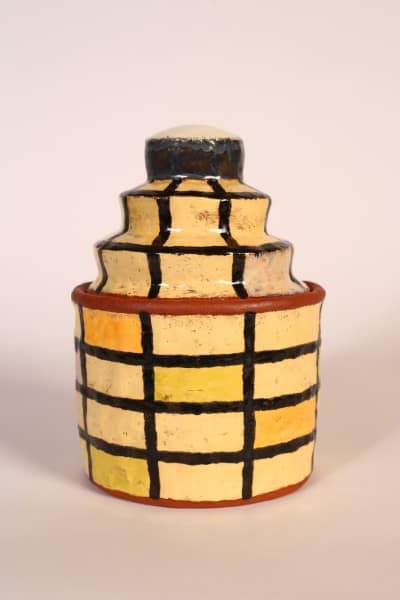
Her hand building method involves a combination of coiling and pinching clay. She adds coils of clay to her work and then pinches them up to build her pieces.
The pinching process is a slow one. Holly appreciates the time this gives her to visualize her pottery as it takes shape. She describes her relationship with the clay as collaborative and intuitive.
Holly states that her pieces are “pinched to create a visual tempo and rhythm that is inherent in the process of building”. She loves that the texture on the pot comes out of the pinching process, rather than being applied or stamped. And she thinks of her hands as her tools.
She also describes how she might consciously consider how the marks best reflect the form they make. Or the marks might be unconscious.
Holly prefers to work with earthenware clay because of the “physicality of earthenware clay in nature”. (source) She talks about the clay being ground down by nature. The clay moves in and percolates through water, becoming mixed up with organic matter.
Designs and Color
The design of her vessels is minimalist, and she describes being drawn to ‘austere, spare forms’. However, she uses the shape of the pot to inform often geometrical decorative designs.
Her background is one of painting, and she does decorate her pottery in a painterly way. The colors that she uses are lively and bold. And she describes herself as drawn to “playful, rich, oddball colors”. She builds up her decorative designs using colored slips and glazes.
In addition to this, she takes inspiration from historical and modern painters. One example of this influence is seen in her vessel “Mondrian Jar”.
Lilly Zuckerman
Lilly Zuckerman is from Pittsburg and grew up in rural PA, US. She studied for her BFA in ceramics at Pennsylvania State University. And she finished her master’s in ceramics at the University of Colorado. She has had a number of residencies and has exhibited widely throughout the US.
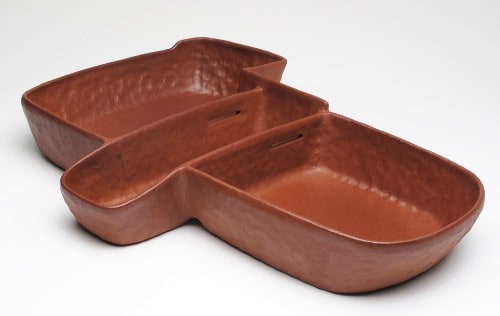
Lilly experimented with different methods of hand building during her BFA. And finally, she found that pinching was her preferred method of making pottery.
Lilly starts her work with a block of clay, which she throws into a slab. She then presses the slab with her fingertips to mark out where the walls of the piece will be. Once she has planned this out, she starts to pinch up the walls of her piece.
She describes the process of pinching as one of ‘give and take’. At times when she’s pinching the clay, she will ‘impose my ideas on the form’. At other times, the clay and the piece will guide her and she will ‘respond accordingly’. (source)
Lilly describes pinching the clay with a slow even rhythm. Lifting and pinching the walls of the piece upwards.
She glazes her pieces by spraying them with diluted clear glaze. Her work is sprayed with 2 or 3 layers of glaze. She prefers her work to have a satin sheen rather than a glossy finish. Her work is then single fired in an electric kiln to cone 03.
Final Thoughts
It has been exciting writing this article about some amazing pinch pot artists. I hope that you have been inspired by the methods and artwork of these pinch pot artists. And that it’s got you fired up to experiment with this satisfying and versatile way to work with clay.



